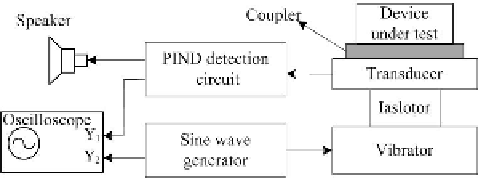Information Technology Reference
In-Depth Information
Fig. 1.
PIND system of MIL-STD-883E method
The Particle Impact Noise Detection (PIND)testisatraditional screening
technique which is used to detect free particles in hermetical components and
specified in MIL-STD-883E standard [2]. Fig. 1 represents the structure of PIND
system. A vibrator generates a series of shocks and vibrations. These shocks can
free the particles and vibrations make them to collide with the component's
walls. The collided energy is captured by the acoustic sensors and outputted in
the forms of sounds and voltage, which can be used to estimate the existence of
loose particles by watching the waveforms on an oscilloscope or listening to the
sound from a speaker.
The PIND test is a typical method for detecting the presence of loose particles
inside the electromagnetic relay. However, due to the many subjective factors of
operators, wrong conclusions are easily drawn, and the accuracy is only about
50% [3]. Therefore, some researchers have proposed several approaches of the
automatic detection and material identification of particles. Considering the co-
ecient of restitution and quality of particles, dynamical mathematical model
is established for particles collision within aerospace relays. The best vibration
condition is derived, and it indicates that output power of the particle is in
proportional to the vibration acceleration and the amplitude of velocity of vi-
brator [4] [5]. For the relays, material identification has also been studied by
analyzing the acoustic signal pulse duration, the spectrum shape factor and the
linear prediction coecients as the features [6]. The disturbance signal energy
distribution vectors in vibration acceleration are used to classify tin, glass and
rubber particle based on back propagation (BP) neural networks [7]. In addition,
a material identification method is presented by employing wavelet and neural
networks for aerospace power [8].
However, the features directly obtained from frequency and wavelet domains
depend on experience. This can result in overlapping and redundancy. As a
result, the actual performance of the particle impact acoustic method based on
direct features selection will be seriously affected for large and complex space-
borne electronic equipments.
To solve this problem, nine features of impact acoustic signals are selected
from time domain and frequency domain. PCA is then used for further fea-
ture extraction, dimension reduction and de-noising. The first six principal com-
ponents are used as inputs to a SVM model. This led to the proposal of a
novel particle material identification method based on PCA and multi-SVM for

Search WWH ::

Custom Search